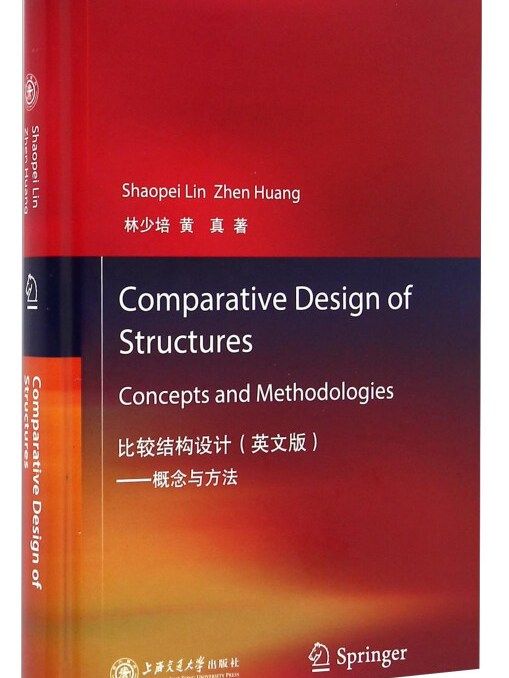《比較結構設計—概念與方法(英文版)》是一本2016年上海交通大學出版社出版的圖書,作者是林少培、黃真。
基本介紹
- 中文名:比較結構設計—概念與方法(英文版)
- 作者:林少培、黃真
- 出版社:上海交通大學出版社
- 出版時間:2016年6月1日
- 頁數:404 頁
- 開本:16 開
- 裝幀:精裝
- ISBN:9787313150813
內容簡介,圖書目錄,
內容簡介
《比較結構設計 概念與方法(英文版)》針對結構概念設計提出了比較設計的理念,重點表現合理化、可持續的結構性能。基本構件的機械特徵通過3D結構進行展示,詳細研究元素的組成與拆分,以便很好地理解如高層建築、大跨通道和空間結構等多樣化的結構。
圖書目錄
Chapter 1 Introduction of Design Philosophy
1.1 The Essentials of Engineering Design
1.2 The Concept of Comparative Design
1.2.1 Design Space Theory
1.2.2 The Fuzzy Expression of Pd
1.3 From Empirical to Intelligent Design
1.4 Functional Aspect of Design
1.5 On Sustainable Development
1.6 On Aesthetics in Design
1.6.1 Principles in Consideration of Aesthetics
1.6.2 National Characteristics in Aesthetics
1.7 Conclusions
Chapter 2 Introduction to Structural Design
2.1 The Features of Modern Structures
2.2 The Processes of Structural Design
2.3 The Process of Architectural Design
2.3.1 The Elements of Architectural Design
2.3.2 The Relation Between Structure and Architecture
2.3.3 The Process of Architectural Design
2.3.4 The Application of Structural Concepts in Architectural Design
2.4 The Structural Behavior and Design Principles
2.4.1 The Structural Behavior and Energy Principle
2.4.2 Overall Stability of Structure and Stability in Its Geometric Composition
2.4.3 The Upper-and Lower-Bound Theorem in Limit Analysis of Structure
2.4.4 Instability and Structural Dynamics
2.4.5 Fundamental Principles of Structural Design
2.5 The Loadings Analyses
2.5.1 Vertical Load
2.5.2 Wind Load
2.5.3 Seismic Load
2.5.4 Other Loads and Effects
2.6 The Acting Loads and the Structural Deformation Response
Chapter 3 Global Design of Structures
3.1 The Classification of Structural Systems
3.2 Methods of Global Analysis of Structures
3.3 Facade Allocation Analysis Through "Force Flow" Method
3.4 Planar Layout Analysis Through "Footprint" Method
3.5 External Configuration and Balancing Design of Structures
3.6 Decomposition of Asymmetric Complex Structures
3.7 Overall Structural Performance
3.8 Conclusions
Chapter 4 Systematic Analyses of Substructures
4.1 Analyses of Structural Components
4.1.1 Analysis of Horizontal Components
4.1.2 Analysis of Vertical Components
4.2 Analysis of Prestressed Structural Elements
4.3 Structural Joints and Connections
4.4 Decomposition of Structural Systems
4.5 Integrated Structures and Substructures
4.6 Characteristics and Simplified Analysis of Horizontal Substructure Systems
4.6.1 Characteristics of Horizontal Substructure Systems
4.6.2 Simplified Analysis of Horizontal Substructure Systems
4.7 Characteristics and Simplified Analysis of Vertical Substructure Systems
4.7.1 Characteristics of Vertical Substructure Systems
4.7.2 Classification and Simplified Calculation of Vertical Substructure Systems
4.8 Conclusions
Chapter 5 Comparative Design and Analyses of High-Rise Buildings
5.1 Characteristics of High-Rise Structures
5.1.1 General Characteristics
5.1.2 Overall Analysis of Vertical Structures
5.2 Design of Shear Wall Structures
5.3 Design of Frame Structures
5.4 Design of Tube Structures
5.5 Design of Mixed Vertical Structures
5.5.1 Skip-Floor Truss Structural System
5.5.2 Giant Frame Structures
5.5.3 Connecting-Tower Structural System
5.5.4 Framed Tube Structural System
5.5.5 Suspended Core-Tube Structural System
5.5.6 Inclined Column Truss Structural System
5.6 Comparative Analyses of Milestone High-Rise Buildings
5.6.1 Outer Trussed Tube-in-Tube System in Shanghai World Financial Center
5.6.2 The World Trade Center in New York, USA
5.6.3 Beijing CCTV Tower
Chapter 6 Comparative Design and Analyses of Large-Span Structures
6.1 Characteristics of Large-Span Structures
6.2 Design for Arch Structural System
6.3 Design for Suspension Cable Structural System
6.4 Design for Cable-Stayed Structural System
6.5 Comparative Analyses of Well-Known Large-Span Structures
6.5.1 Shanghai Lupu Bridge
6.5.2 Guangxi Nanning Bridge
6.5.3 Jiangyin Yangtze River Bridge
6.5.4 Gibraltar Strait Bridge
6.6 Conclusions
Chapter 7 Comparative Design and Analyses of Spatial Structures
7.1 Characteristics of Spatial Structures
7.2 Design for Spatial Truss and Grid Structural System
7.3 Design for Latticed Shell Structural System
7.4 Design for Membrane Structural System
7.5 Design for Spatial Deployable Structural System
7.6 Comparative Analyses of Sophisticated Spatial Structures
7.6.1 Shanghai New International Expo Center
7.6.2 Beijing National Center for the Performing Arts
7.6.3 The Georgia Dome
7.6.4 Kunming Peacock Art Square of World Garden Expo
Chapter 8 Intelligent Design Based on Knowledge Engineering
8.1 Introduction of Intelligent Design
8.2 Fuzzy-AI Model Applied to Comparative Design
8.2.1 The Fuzzy Expression of Pd
8.2.2 Fuzzy Reasoning of the Intelligent Design
8.2.3 How Fuzzy-AI Model Works in Intelligent Design?
8.3 Mathematical Modeling of Design Space
8.4 Fuzzy Mathematical Distance in Design Space
8.4.1 Fuzzy Mathematical Distance by Membership Difference
8.4.2 Fuzzy Mathematical Distance by Nearness Degree
8.5 Fuzzy Reasoning and AI-Machine Learning Model
8.5.1 AI-Machine Learning Model
8.5.2 Machine Learning Modeling
8.6 Neural Network Reasoning for Structural Design Parameters
8.6.1 Neural Network (NN)
8.6.2 Fuzzy Neural Network (Fuzzy-NN)
8.6.3 Fuzzy-NN Architecture for Machine Learning
8.6.4 Conclusive Remarks
8.7 Fuzzy Neural Network Model for Structural Design
8.7.1 Introduction
8.7.2 Neural Network Back-Error Propagation Learning
8.7.3 NN Machine Learning for Sample Classification
8.7.4 The Implementation of Fuzzy Machine Learning
8.7.5 Fuzzy-NN Machine Learning for Structural Design
8.8 Conclusions
Conclusion
Appendix A
Appendix B
References

